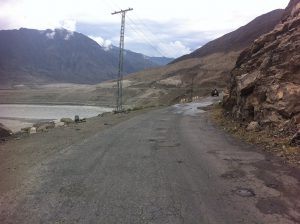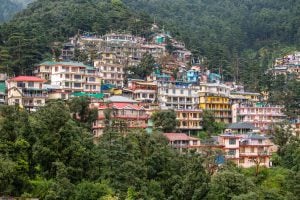There is a Nepali saying, “Wise action is the fruit of life, wise discourse is the pollination.” This was one of the many things about pollination that Sonam Dorji, from Bhutan’s central district of Bumthang, heard from his grandparents. It inspired him to take up beekeeping, which he made into a source of income in 2004.
Dorji is one of the beekeepers in Bumthang, a place usually abuzz with excitement at this time of the year, with the harvesting season just around the corner. However, the prospects look bleak this year, as bees keep dying and honey production has dropped over the past few years.
See: Plants and insects ignored in Bhutan’s conservation efforts
Beekeepers in Jalikhar, a village in Bumthang, have noticed that bees leave the hive during the day and never come back. Of the 160 hives there, 120 have no bees left in them. The community has stacked up the empty hives in a storehouse.
“Usually, by this time we place the honey super atop the hives to gather honey, but this year there is no point,” Dorji said. A large number of people in Bumthang and other districts depend solely on the sale of honey for their livelihoods. Usually each member of the beekeepers’ cooperative earns more than BTN 200,000 (about USD 2,680) annually, but that is not going to happen this season.

Changing weather patterns is a key reason. According to Towchu Rabgay, a Department of Livestock officer, erratic rainfall has been detrimental to the flower blossoms from which the bees collect the nectar to make their honey.
See: Climate change, deforestation, cripple Pakistan’s honey exports
Tul Bhadur Chhetri, chair of the Beekeepers’ Cooperative of Bhutan in Bumthang, said that of 1,100 hives in the cooperative, entire colonies have been wiped out in more than 800. He said the uneven flowering caused by erratic rainfall is not enough to explain this.
“We reported this mass death of bees to the dzongkhag [district] administration and the administration asked the Renewable Natural Resources (RNR) Research Centre [the key research institution of the Ministry of Agriculture and Forests] to study the causes,” Chhetri said. While the centre noted that “inadequate natural forage (pollen and nectar) during autumn season when colonies are multiplied after first honey harvest” might be the reason, beekeepers have noticed the bees leaving yellowish droppings, as if they have diarrhoea. The bees then leave the honeycomb and die outside the hive. Chhetri observed this could mean the bees have been exposed to a new disease.
A third menace has appeared in parts of southern Bhutan: an ant species unknown to the locals. The ants, farmers say, get into the beehives and damage them.
The farmers in the gewog (a group of villages) of Dophuchen started commercial beekeeping last year. Five farmers sold honey for the first time, earning a good income.
Purni Maya is one of them. The 27-year-old started raising a species of bee known as Apis trigona, whose honey is expected to fetch a staggering BTN 7,000 (about USD 94) per kg. But now there are more ants than bees in over half of her 12 beehives.
“I don’t know what to do to stop the ants from entering the hives and destroying them,” she said. Before she decided to raise rarer types of bees, she used to sell about 9 kg of honey for BTN 500 (USD 7). She no longer has bees that make the less expensive honey, and her supply has dwindled.
Maya said the ants appear during the summer months – the time to harvest honey.
The farmers have sent a sample of the ant to the National Highland Research Development Centre in Bumthang. They hope that identifying the insect will help them come up with ways to prevent the ants from entering the beehives.
Exports could ease pain
In 2017, the Department of Livestock’s national apiculture programme collected about 48,270 kg of honey. This increased to 65,850 kg in 2018. Though the data for 2019-20 is not yet available, it is likely that production has dropped steeply.
Rabgay, from the Department of Livestock, said that around 60% of this honey is exported. As well as not being able to meet orders, farmers have sold their stock for less than it is currently worth. Having previously agreed an export price, the market rate has increased as supply has fallen.
The Covid-19 pandemic has also badly affected the business. One way to offset the losses may be to look at the export market. There are 104 members registered with the Beekeepers’ Cooperative of Bhutan, which buys honey from its members and has a micro-financing scheme. The cooperatives have approached the district administrative departments for support and talked with the Agricultural Marketing and Cooperatives Department about honey exports.
Tsheten Dorji, a board member of the Beekeepers’ Cooperative of Bhutan in Bumthang, said, “Our cooperative was certified by the International Organisation for Standardisation about two years ago. However, we have never tried exporting our honey, as our harvest can’t even meet the local demand. Nevertheless, it would be helpful for us if the government can find a market for us overseas. Our product has the quality that meets international standards, so we have the potential to export it.”
See: Bhutan uses Covid-19 crisis to boost agriculture
The agriculture ministry is exploring how to export the cooperative’s honey. Sonam Wangchuk, from the ministry’s RNR Enterprise Development Coordination Unit, said it has talked with three individuals about exporting the products to the United States and Europe when flight restrictions are eased and international markets return to normal.
Currently, there are 83 members in the Bumthang cooperative. It is the largest honey-producing cooperative in the country with a yearly harvest averaging 20 metric tonnes.
Crop diversity
The flourishing of the honey trade has happened alongside a rise in the popularity of buckwheat, which the bees pollinate. In the winter and summer seasons, buckwheat fields help to increase the annual honey crop, as well as aiding farmers who do not have their own bees. While the uneven flowering of the buckwheat may have been partially responsible for bees’ decline this year, the crop could provide an additional source of income for the beekeepers of Bhutan.

Buckwheat is a traditional part of the diet for the people of the region. In recent decades it has been superseded by potatoes. But Gaylang, the dzongkhag’s agriculture officer, said that since 2012 the district has started to reintroduce buckwheat.
“In 2012, buckwheat took up 604 acres. Now we have reached 800-1,000 acres and it is increasing due to high demand in the market as well as for bees’ survival,” he said, adding that it is important to maintain crop diversity in the field to cope with climate change.
Ap Chungdu, a local beekeeper, said that rearing bees has also promoted fruit crops in Bumthang. “The majority of the households in Bhutan are blessed with ample fruit and flower plantations,” Chungdu said.
Bumthang, with its lush flora, is ideally suited to be the lynchpin in an economy that combines beekeeping, buckwheat and fruit trees. This makes ending the decline in the honeybee population all the more urgent.
Also see: Pakistan is losing its honeybees due to climate change
![<p>Erratic rainfall in Bhutan has been detrimental to the flower blossoms from which the bees collect nectar [image by: Mateusz Atroszko/Alamy]</p>](https://www.thethirdpole.net/content/uploads/2020/07/honeybees-dying-Bhutan-300x200.jpg)



![Flooding along the Bagmati is an annual phenomenon in Bihar [image: Alamy]](https://www.thethirdpole.net/content/uploads/2020/07/Floods-hit-Bihar-300x197.jpg)

